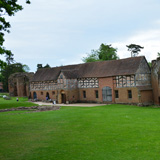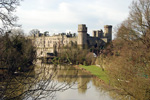History
Kenilworth Castle was built in the 1120s by Geoffrey de Clinton. Geoffrey was King Henry I's Lord Chamberlain and treasurer and was granted the royal estate of Stoneleigh by the King. Geoffrey would build a priory on the lands but set aside enough land to begin the construction of Kenilworth Castle, starting with the Keep.

Henry II succeeded to the throne at the end of the Anarchy but faced an uprising from his son, also named Henry, in 1173, who was backed by the French crown. Henry II would take the castles at Kenilworth and Warwick into his own hands and garrisoned them against attack from his son. After the rebellion ended, Henry II gave the de Clinton family other lands and kept Kenilworth Castle in royal possession. Repairs to the castle are recorded in the royal account from 1179 onwards, including a reference to the Keep in 1190.
Between 1210 and 1215, King John improved the castle, completing the Keep and constructing the outer curtain wall and a dam to hold back a great lake. Kenilworth Castle was one of four castles to be handed over to the Northern Barons as a guarantee for John upholding the agreements documented in the Magna Carta. Still, John somehow managed to avoid surrendering Kenilworth Castle.
In 1241, despite rarely visiting the castle, King Henry III ordered improvements to the royal apartments, the refurbishment of the chapel, and the reroofing of the King's Chamber.
King John's youngest daughter, Eleanor, married Simon de Montfort in 1238. Henry made de Montfort, Earl of Leicester, in 1244, giving him custody of Kenilworth Castle. Simon de Montfort became dissatisfied with Henry's treatment of his family and made cause with other barons who had lost power and influence. De Montfort became a leader in the Second Barons' War against the King. After the Battle of Lewes in 1264, de Montfort controlled England when the King's son, future King Edward I, and the King's brother, the Earl of Cornwall, were imprisoned by de Montfort at Kenilworth Castle. Edward managed to escape after being moved to Hereford.
Prince Edward raised an army and attacked de Montfort's army outside Kenilworth Castle at dawn. De Montfort's son and a few others managed to escape the attack by swimming across the Great Mere into the castle. Three days later, on August 4th, 1265, Edward would win the Battle of Evesham, where Simon de Montfort was killed. Kenilworth Castle would hold against the Siege of Kenilworth Castle in 1266, the largest and longest siege in English history, lasting almost six months. The castle's water defenses made besieging the castle more difficult, which Prince Edward would remember when he set out to build his iron ring of castles in Wales later on.
In 1267, Henry II granted Kenilworth Castle to his youngest son, Edmond Crouchback. Edmund held many tournaments at the castle, including a significant event in 1279 presided over by the royal favorite Roger de Mortimer, in which a hundred knights competed for three days. The event was called "The Round Table," imitating famous legends of King Arthur. Edmund passed the castle to his eldest son, Thomas, Earl of Lancaster, in 1298, and Kenilworth replaced Bolingbroke as Thomas's social and financial center. Between 1314 and 1317, Thomas added the Great Hall and the Water Tower along the outer bailey.
The Earl of Lancaster would eventually fall out with King Edward II, and in 1322, Lancaster was captured at the Battle of Boroughbridge and executed. The crown confiscated Kenilworth Castle. Edward II and his wife, Isabella of France, spent Christmas of 1323 at the castle, partaking in significant celebrations. In 1326, Edward II was deposed by an alliance between his wife, Isabella, and her lover, Roger Mortimer. Edward was captured by Isabella's forces and held by Henry, Earl of Lancaster, who backed her invasion. Henry was made constable of Kenilworth Castle and transported Edward II there in late 1326. Edward formally resigned as King in the Great Hall of Kenilworth Castle on January 21st, 1327. He would later be moved to Berkeley Castle, where he would die in suspicious circumstances shortly afterward.
In 1347, Henry, Duke of Lancaster, added a new roof for the Great Hall at Kenilworth Castle. Henry's granddaughter, Blanche of Lancaster, married John of Gaunt, the fourth son of King Edward III. Between 1373 and 1380, John developed the castle into a palace by improving the Great Hall and adding the Strong Tower, Saintlowe Tower, and lavish state apartments. The Duchy of Lancaster passed to the Crown when Henry Bolingbroke became King Henry IV in 1399. His son, King Henry V, found Kenilworth Castle too public and had a pavilion built at the far end of the Great Mere, which he called Le Plesaunz en Marys, the pleasure house in the marsh.
With Henry VII's victory at the Battle of Bosworth Field, Kenilworth Castle again received royal attention. His son, Henry VIII, decided it should be maintained as a royal castle. He had Henry V's Pleasance moved into the central part of the castle. In 1553, the castle was given to John Dudley by an exchange, but when the boy King Edward VI died later that year, John attempted to put his daughter-in-law, Jane Grey, on the throne. Within two weeks, a popular rising placed Henry VIII's daughter, Mary Tudor, on the throne, and John Dudley was executed at the Tower of London.
In 1563, Kenilworth Castle was restored to Dudley's son, Robert, Earl of Leicester, four years after Elizabeth I succeeded to the throne. Elizabeth held Robert in high favor, and rumors spread that the two might marry. Elizabeth visited the castle in 1566 and 1568 as Dudley made improvements. On her last visit in 1575, she brought an entourage of thirty-one barons and four hundred staff who spent nineteen days at the castle.
In 1644, King Charles I spent a night at Kenilworth Castle. The castle would change hands a few times during the Civil War. After the Battle of Edgehill, the royalist garrison at the castle was withdrawn and was then garrisoned by parliamentary forces. In 1649, Parliament ordered the slighting of the castle to make it indefensible by destroying one wall of the Great Tower or Keep and various sections of the outer bailey.
Today, the ruins of Kenilworth Castle are in the care of English Heritage, which maintains the castle and opened it to the public in 1984. In June 2024, eight 13th century catapult shots were discovered on the grounds. They are believed to be from the siege of 1266.
Castle Highlights
Kenilworth Castle is a ruin today, but plenty remains of the massive red sandstone castle to understand what it would have looked like if still intact. If not for the Civil War and the slighting of the castle to make it indefensible, Kenilworth Castle would rival nearby Warwick Castle in size.
As you approach the castle from the car park and gift shop, the first part of the castle you encounter is the gatehouse that links to the outer curtain wall surrounding the castle. Two "D" shaped towers flanked on each side of the passageway leading through the gatehouse were added in the 13th century. The gatehouse became known as Mortimer's Tower after a stone-carved shield featuring the coat of arms from the Mortimer family that once could be seen on the tower walls.
The most impressive part of the castle is the Norman Keep. The Keep rises from a solid plinth that slopes back by many narrow ledges to a considerable height. This made the use of battering rams almost useless in attacking the castle, as they would only hit packed earth instead of the stone walls of the Keep above the earthworks. The Keep stands three stories high and has a large forebuilding with a covered entranceway. The top floor of the Keep contained a fighting gallery with arrow slits. Large Tudor windows were added to the Keep later on.
The Great Hall is also impressive and has a three-sided oriel window to give the lord of the castle some privacy at mealtime and some protection from draughts. It has a fireplace and a view over the inner courtyard. The Great Hall has two stories. The lower level was a storage basement and lit by narrow loopholes facing the inner courtyard. The top floor was once one of England's finest 14th century rooms, with four giant windows and a grand fireplace. It contained seats carved into the window recesses, which were used to carry out work involving writing or sewing in the best light.
The outer courtyard also has interesting areas to explore, including the formal Elizabethan Gardens, restored to their former glory, the Stables, and Leicester's Gatehouse.
Kenilworth Castle can take between 2 hours and all day to explore. Suppose you only want a quick 2-hour visit. In that case, I recommend exploring nearby Warwick Castle the same day and visiting Warwick Castle first, as it has daily events such as jousting and falconry, and then visiting Kenilworth mid-afternoon. They are located about 10 miles from each other.
Kenilworth Castle is also haunted.



